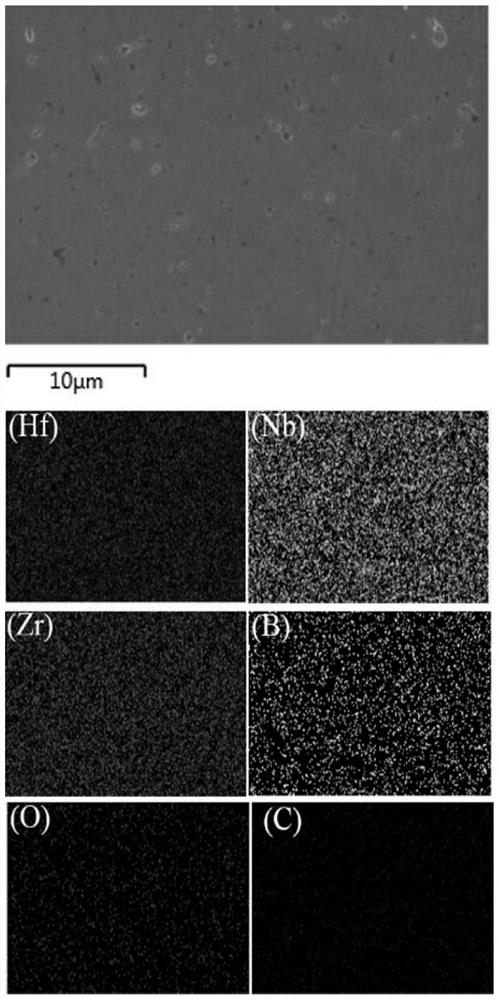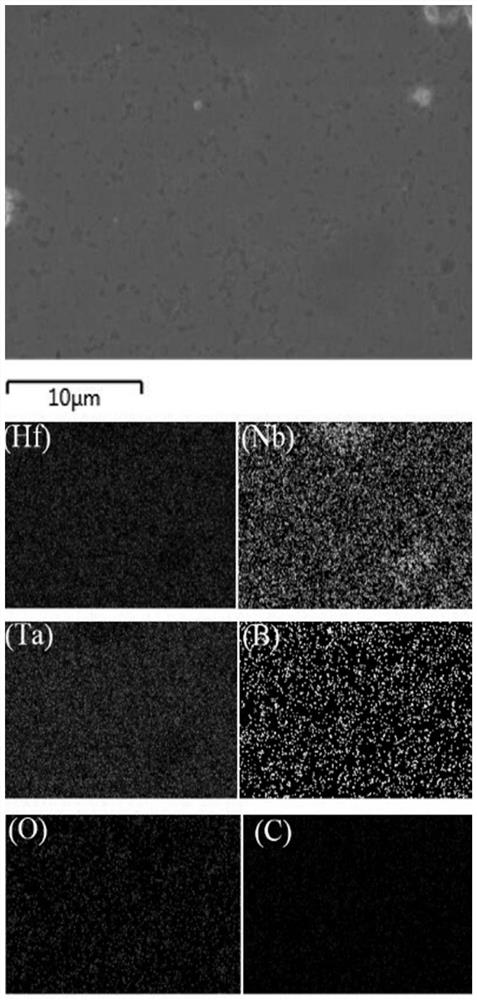Hafnium-niobium-based ternary solid solution boride conductive ceramic and preparation method and application thereof
A conductive ceramic and boride technology, applied in the field of ceramic materials, can solve the problems of reducing inherent mechanical strength and high temperature performance, difficult sintering and compacting of transition metal borides, reducing mechanical properties of ceramics, etc., and achieves short sintering time and small grain size. , the effect of small internal defects
- Summary
- Abstract
- Description
- Claims
- Application Information
AI Technical Summary
Problems solved by technology
Method used
Image
Examples
Embodiment 1
[0030] 1. With HfO 2 (powder purity 99%, particle size 1μm), ZrO 2 (purity of powder 99.8%, particle size 1 μm), Nb (purity of powder 99%, particle size 10 μm), and B 4 C (powder purity 99.9%, particle size 0.5 μm), carbon powder (powder purity 99%, particle size 0.8 μm) as raw materials, ethanol as solvent, Si 4 N 3 As a ball milling medium, mix on a ball mill for 24 hours, and obtain a mixed powder after drying;
[0031] 2. Put the molded green body of the mixed powder into a graphite crucible, raise the temperature to 1600°C at a rate of 10°C / min and keep it warm for 1h, and obtain (Hf 1 / 3 Zr 1 / 3 Nb 1 / 3 )B 2 Hafnium and niobium based ternary solid solution boride conductive ceramic powder.
[0032] 3. Will (Hf 1 / 3 Zr 1 / 3 Nb 1 / 3 )B 2 The hafnium-niobium-based ternary solid solution boride conductive ceramic powder is placed in a graphite mold, and the temperature is raised to 1000°C at a rate of 150°C / min by spark plasma sintering and filled with an Ar protective ...
Embodiment 2
[0036] 1. With HfO 2 (powder purity 99%, particle size 2μm), TiO 2 (purity of powder 99.8%, particle size 2 μm), Nb (purity of powder 99%, particle size 10 μm), and B 4 C (powder purity 99.9%, particle size 0.5 μm), carbon powder (powder purity 99%, particle size 0.8 μm) as raw materials, ethanol as solvent, Si 4 N 3 As a ball milling medium, mix on a ball mill for 24 hours, and obtain a mixed powder after drying;
[0037] 2. Put the molded green body of the mixed powder into a graphite crucible, raise the temperature to 1600°C at a rate of 10°C / min and keep it warm for 1h, and obtain (Hf 1 / 3 Ti 1 / 3 Nb 1 / 3 )B 2 Hafnium and niobium based ternary solid solution boride conductive ceramic powder.
[0038] 3. Will (Hf 1 / 3 Ti 1 / 3 Nb 1 / 3 )B 2 The hafnium-niobium-based ternary solid solution boride conductive ceramic powder is placed in a graphite mold, and the temperature is raised to 1000°C at a rate of 150°C / min by spark plasma sintering and filled with an Ar protective ...
Embodiment 3
[0041] 1. With HfO 2 (powder purity 99%, particle size 1μm), TiO 2 (purity of powder 99.8%, particle size 1 μm), Nb (purity of powder 99%, particle size 10 μm), and B 4 C (powder purity 99.9%, particle size 0.5 μm), carbon powder (powder purity 99%, particle size 0.8 μm) as raw materials, ethanol as solvent, Si 4 N 3 As a ball milling medium, mix on a ball mill for 24 hours, and obtain a mixed powder after drying;
[0042] 2. Put the molded green body of the mixed powder into a graphite crucible, raise the temperature to 1600°C at a rate of 10°C / min and keep it warm for 1h, and obtain (Hf 1 / 4 Ti 1 / 4 Nb 1 / 2 )B 2 Hafnium and niobium based ternary solid solution boride conductive ceramic powder.
[0043] 3. Will (Hf 1 / 4 Ti 1 / 4 Nb 1 / 2 )B 2 The hafnium-niobium-based ternary solid solution boride conductive ceramic powder is placed in a graphite mold, and the temperature is raised to 1000°C at a rate of 150°C / min by spark plasma sintering and filled with an Ar protective ...
PUM
| Property | Measurement | Unit |
|---|---|---|
| particle diameter | aaaaa | aaaaa |
| particle diameter | aaaaa | aaaaa |
| particle diameter | aaaaa | aaaaa |
Abstract
Description
Claims
Application Information
 Login to View More
Login to View More - R&D
- Intellectual Property
- Life Sciences
- Materials
- Tech Scout
- Unparalleled Data Quality
- Higher Quality Content
- 60% Fewer Hallucinations
Browse by: Latest US Patents, China's latest patents, Technical Efficacy Thesaurus, Application Domain, Technology Topic, Popular Technical Reports.
© 2025 PatSnap. All rights reserved.Legal|Privacy policy|Modern Slavery Act Transparency Statement|Sitemap|About US| Contact US: help@patsnap.com


